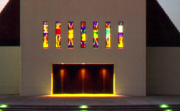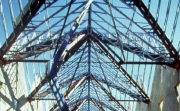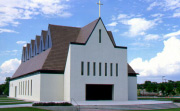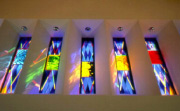All Saints Chapel at The Episcopal School of Dallas
Why Did the Owner Select Tilt-Up?
The building program for All Saints Chapel at the Episcopal School of Dallas called for a transcendent religious space that would be a different experience each day for 500 students at the required ESD daily worship. The space needed to be designed for music with a three second reverberation time. And finally, this all had to be achieved with a $2,000,000.00 budget.
To achieve this reverberation time and seat 500 children, the space needed to be at least 45 feet high. Large dormer windows were added in the roof plan to increase the height of the interior vertical walls to achieve the reverberation time. Also the walls needed to be very dense to allow the sound to reverberate. When the acoustician's recommendation of three layers of drywall and metal stud framing proved too expensive and pushed the budget over by $500,000.00, the Architect and Structural Engineer chose tilt-wall construction. Since a single panel could rise up to forty-five feet high and provide the ideal density for sound reverberation, the drywall and expensive steel and light gauge framing could be eliminated. The choice of tilt wall saved $500,000 and put the project back in budget.
There was some fear with the owner that it would not finish out to look acceptable for the interior (and exterior) of a chapel. In the end, everyone agreed, that tilt-wall was the only solution because it was so appropriate and created a sense of scale that no other product could achieve.
What was the Overall Complexity of the project?
The tilt-wall scheme consisted of a box within a box. Please see drawings, which will be coming by October 15th. The greatest challenge for the tilt-wall was the staging of the erection. The panels were not conventional shapes and casting slabs were needed and strategically placed to facilitate ease of erection. First, poured in place columns were erected on either side of the nave. Next, the tilt-wall panels were placed on top of the columns and around the altar area and narthex. After these panel were erected, the outer panels were cast and tilted into place. The roof framing steel was added with sheathing and then the building was dried in.
What was the project mission?
The mission of the Episcopal School of Dallas is to prepare young people having a variety of backgrounds, academic skills, aptitudes, and other attributes for college. This is best accomplished by providing a co-educational, faith-centered environment which fosters intellectual, spiritual, physical, emotional, and social maturity, as well as the precepts of responsibility and giving. The Episcopal School of Dallas was created to structure the life of the community around the precepts of the Mission Statement. The Founding Tenets of the Episcopal School were created simultaneously with the original Mission Statement and are: DAILY WORSHIP - Allows recognition of God, the teachings of the Judeo-Christian heritage, and the personal and global contemporary issues which require personal and corporate prayer and responses. EXPERIENCES OF COMMUNITY - Allows the common needs of fellow human beings to be shared, lived and discussed in advisories, wilderness camping and headmaster retreats. STUDIES IN RELIGION -Allows the development and inculcation of a belief system through structured, traditional classroom settings. SERVICE TO OTHERS - Allows students to experience the giving of their time to work on campus and in various service agencies throughout the city. The Tenets of worship, an experience of community and study, prepare members of this community for the fourth Tenet....SERVICE, the highest manifestation of God's action in our lives.
What were the special architectural treatments?
The interior concrete tilt wall panels were finished with a smooth plaster coating. The edges of the panels were carefully formed to 90 degree corners instead of standard beveling. The front and rear facades of the chapel were cast as a single panel to save money. The exterior panels were covered with a thin concrete coating to seal the concrete and provide a uniform texture.
What was the success of the project?
The achievement of acoustical perfection in the chapel is chiefly due to the height and mass of the concrete tilt wall panels. The ceiling design provides indirect light to create a mysterious, mystical, spiritually space.
What were the outstanding features?
The stiffness inherent in the concrete panels allowed for a special ceiling treatment. To stiffen and stabilize the interior panel, a new cable roof structure was designed. The new system, based on the theories of Buckminster Fuller and artist Kenneth Snelson, was called the tensegrity tie bars. These structures retained their shape while in tension which was supplied by the outward thrust of the roof structure. Because they retained their shape while in tension, an allegory of the atom - the building block of our world - was suggested. The light structure of the tensegrity tie bars was also reminiscent of Gothic tracery in the old cathedrals.
On the exterior, a custom steel gutter system was utilized to terminate the top of the exterior concrete panels. The proportions of this system were derived from the frieze at the Parthenon.
The treatment of the corner intersection cast a false corner joint to make butting two panels together at a corner beautiful. Notice how the gutter joints align with the concrete joints. Our inspiration on this detail was Mies van der Rohe.
What additional features or comments should be made?
This project should receive an award because it utilized a material and construction technique normally used for warehouse and retail structures to create an awe inspiring transcendent worship space. Also, this project would never have been constructed without the economy of tilt-wall construction.
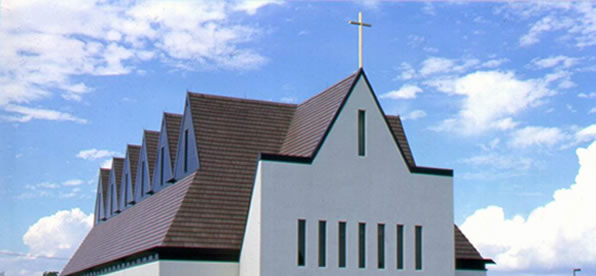
Project Location
Dallas, TX 75229
United StatesA
TILT-UP ACHIEVEMENT AWARD
The Tilt-Up Achievement Awards were established to honor projects that use site-cast tilt-up concrete to introduce new building types, advance industry technology and provide unique solutions to building programs. Winning entries illustrate the variety, beauty, and flexibility of tilt-up construction.
ACHIEVEMENT
2003
The world’s greatest tilt-up structures are featured by the TCA as Tilt-Up Achievement Award Winners. Learn more >
Project Images
Project Team (TCA Members)
- General Contractor:
- Concrete Contractor:
- Architect:
- Engineer:
- Datum Engineers Inc
- Suppliers:
- Nox-Crete Products Group
- Photographer(s):
Project Specifics
- Project Category:
- Worship
- Building Types:
- Finishes:
- Features:
- Insulation:
- Environmental:
- Number of Floors:
- 0
- Tallest Panel:
- 48 ft 0 in (14.63 m)
- Largest Panel:
- 1,000 sq ft (92.9 sq m)
- Heaviest Panel:
- 100,000 lbs (45,359 kg)
